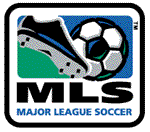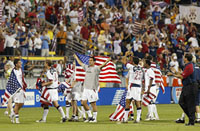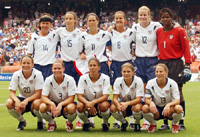 |
|
Sports in America > Soccer |
|
What the rest of the world calls football, is known as soccer in the United States. Originally called association football (the name soccer is a corruption of “assoc” which is derived in turn from association), soccer is distinguished from American or Canadian football and from rugby in that it is primarily played with the feet. Soccer was slow to attract fans in the United States, where such sports as baseball, basketball, and American football were more popular. Today, however, according to FIFA (Fédération Internationale de Football Association), the United States has more official soccer players than any other nation in the world - almost 18 million. No other sport crosses so many cultural boundaries, and it no surprise that it is the fastest growing team sport in the United States. History Peoples around the world have played soccer-style games for centuries. Games similar to soccer were played in China more than 2,000 years ago. Such games were also played in ancient Greece and Rome. When Pilgrim ships first sailed into the harbors of Massachusetts in the 1620s, they discovered Native Americans playing a soccer-like game called pasuckuakohowog, meaning "they gather to play ball with the foot." Playing fields were beaches a half-mile wide with goals one mile apart. As many as 1,000 people played the rough-and-tumble game at a time. Knowing who was on your team wasn't easy because players wore disguises. Matches sometimes lasted for days, and always ended with a magnificent feast. In colonial America, games more similar to modern day soccer were also played. In the early 1800s, a number of North American colleges had soccer teams, but the rules were informal and differed from school to school. The first official soccer club in the U.S. -- the Oneidas -- was formed in Boston in 1862, during the Civil War. A monument now stands on the Boston Common, where the Oneidas played their home matches. Immigrants from Europe to industrial communities in the Northeast and Midwest spurred the development of American soccer in the last part of the 19th century. They brought along their soccer traditions and formed local teams. The first attempt to establish a professional soccer league dates back to 1884 when the "American League of Professional Football" was founded but it closed during the same year.
International Participation The U.S. Soccer Federation was established in 1913. The same year it joined the world governing body FIFA. The first official national championship tournament was played in 1914. Predecessor to the U.S. Open Cup, it is the oldest cup competition in United States soccer and is among the oldest in the world. The annual U.S. Open Cup Open is a single-elimination tournament open to all affiliated amateur and professional teams in the United States. The USA was one of 13 nations to compete in the first FIFA World Cup competition in Montevideo, Uruguay. Argentina beat the U.S. in the semi-final and the United States team, who was favored to win, finished third overall. The U.S. competed in 1934 and then in 1950 at the World Cup in Brazil. In the 1950 tournament, the American team beat England 1-0, one of the biggest upsets in soccer that year. The U.S. returned to World Cup competition in 1990, after a 40-year absence. Since then, it has qualified for each tournament. In 1994, the United States hosted the World Cup. That sparked increased interest in the sport and built on the legacy of the North American Soccer League (NASL), which in the late 1970s brought international stars like Pelé and Franz Beckenbauer to the United States. Women’s Soccer
In America the women's game piggybacked the interest created by the men's North American Soccer League. In fact, one of the slogans of the NASL was: "Soccer is a kick in the grass and girls play, too." The women's national team is a very successful international player. It won the first Women's World Cup ever in 1991. Women's soccer became an Olympic sport at the 1996 Atlanta games, and the Americans won the first Olympic gold medal. The United States hosted the Women's World Cup in 1999, and the championship performance of the national women's team was enthusiastically followed in the United States. The championship game generated a higher rating than the finals of professional hockey and basketball. American soccer players became the nation's heroines, appearing in Nike commercials and on the covers of Sports Illustrated and Newsweek. Never before in American history had soccer been given so much attention. Soccer is just as popular for girls as for boys in the United States. Over forty percent of soccer players in the U.S. are women. Soccer is the most popular women's sport in college. An estimated 18,188 women played soccer in the three college divisions in 2001, compared with 17,788 in track and field. In some cases, women soccer stars are more well-known than men. Soccer star Mia Hamm was listed recently as one of the "Most Fascinating Women in Politics" in a political magazine poll.
Youth soccer is played at school and also in leagues run by volunteer-driven organizations such as the "American Youth Soccer Organization" and "US Youth Soccer." Professional Soccer The popularity of youth soccer, and the attention gained when the United States hosted the World Cup in 1994, led to increased interest in the sport in the United States. In 1996 a new outdoor league, Major League Soccer (MLS), debuted with professional teams in 10 U.S. cities. Five years later, in 2001, a U.S. women's professional league, the Women's United Soccer Association (WUSA), began its first season with 8 teams. There are some unique differences between the two leagues. While MLS often loses its best players to overseas clubs and can find few big stars willing to play in the United States, the WUSA faces the reverse situation: it has attracted the very best female players in the world. WUSA was suspended after three seasons in September 2003. Women’s Professional Soccer (WPS), formed in 2007, again will give young women worldwide a chance to play professional football. The first season started in April 2009. |
|||||
Texts are abridged from U.S. State Department IIP publications and other U.S. government materials. |
|||||
Feature Articles [from America.gov] |
|||||
What kind of information materials are available?
CD: These documents are available in fulltext format on the About the USA CD-ROM. Teachers: Request a copy for classroom use. L: Selected documents are available in German as well as other languages, including Arabic, Chinese, French, Spanish, Persian and Turkish. |
DISCLAIMER Any reference obtained from this server to a specific commercial product, process, or service does not constitute or imply an endorsement by the United States Government of the product, process, or service, or its producer or provider. The views and opinions expressed in any referenced document do not necessarily state or reflect those of the United States Government. |



 Kids and Soccer
Kids and Soccer